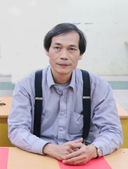Laboratory of Applied Spectroscopy and Gemology
09/11/2021 - 12:18 PM 285 views
CÁC THÀNH TỰU CHÍNH

Department Head
Dr. Nguyen Trong Thanh
|
MISSION:
-
Study on spectroscopy of rare earth, transition metals and defect centers in inorganic materials
MAIN RESEARCH DIRECTION:
-
Optical properties and energy levels of RE, MT, defect centers in crystal and glasses phosphors materials
-
Research fabrication technology and characteristics of ceramic materials for Mid-infrared region applications
|
 thanhnt@ims.vast.ac.vn thanhnt@ims.vast.ac.vn |
 +84 914370239 +84 914370239 |
1. Fabrication and characterization silicate-alkali-earth material CaSiO3, BaSiO3, SrSiO3 doped with Eu2+, Mn2+ for phosphors applications in solid light sources, using high temperature method 1000 -1400 oC, H2 environment. Determination of thermal quenching threshold of materials by TSLES method based on photoionization threshold.
2. Study on the role of alkaline ions Li in enhancing optical properties of Er3+ and Yb3+/ Er3+ in Gd2O3 and CaF2 nanocrystals materials.
-
Li component create a new modifer for the bonds within the "local area network" of the host network. This change lead to enhancement of luminescent, thermoluminescent properties of the RE centers. The energy transfer of Gd-Er (in down conversion luminescence) and Yb-Er (in up- conversion luminescence) gives high luminescence quantum efficiency.
-
TSL thermoluminescence characteristics of CaF2: Er,Li are suitable for application TSL and OSL dosimeters in the radiation dosimetry
3. Research on technology of fabrication infrared transparent ceramics CaF2, MgF2 using pressing methods with high pressure and high temperature based on HIP-2000, LABOX- 350 equipments, Key Lab of Institute of Mateials Science.
Fig. 1. (a) Photographs of infrared ceramic samples MgF2 before and after sintering at 780 oC - 40 MPa - 25min, using LABOX-350 equipment, Institute of Materials Science, (b) morphological of samples ceramic MgF2 after sintering
-
MgF2 ceramic samples have been successfully fabricated with pressure from 20 to 80 MPa, temperature in the range from 600 to 950 oC with high transmition properties in the infrared region from 2 to 7 µm. These SPS technology can be extended to fabricate a number of other optical ceramics such as sapphire and spinel, sulfile...
-
Synthesis of lithium aluminate for application in radiation dosimetry, Materials Letters 267 (2020) 127506
-
Energy level of lanthanide ions and anomalous emission of Eu2+in Sr3B2O6 materials, Physica B 595 (2020) 412373
-
Study on luminescent properties of Tb3+ and Sm3+ co-doped CaSiO3phosphors for white light emitting diodes, Mater. Res. Express 7 (2020) 016507
-
VUV spectroscopy of lanthanide doped fluoride crystals K2YF5, Optical Materials 107 (2020) 110049
-
Preparation and Optical Properties of La3PO7:Eu3+ Nanophosphors Synthesized by Combustion Method, Materials Transactions, 61, 8 (2020) 1564 - 1568
-
Multistep synthesis and upconversion luminescence of spherical Gd2O3:Er and Gd2O3:Er @ silica, Journal of Materials Science: Materials in Electronics (2020) 31:3354–3360
-
Upconversion Luminescence Properties of Gd2O3: Er3+ Nanospheres and Gd2O3: Er3+@Silica Nanocomposites, , Materials Transactions, Vol. 61, No. 8 (2020) pp. 1569 to 1574
-
Luminescence properties of a nanotheranostics based on a multifunctional Fe3O4/Au/Eu[1-(2-naphthoyl)-3,3,3-trifluoroacetone]3 nanocomposite, Optical Materials 109 (2020) 110229
-
Detection of luminescence centers in colloidal Cd0:3Zn0:7S nanocrystals by synchronous luminescence spectroscopy, Communications in Physics, 30, 2 (2020), 181-187
1. TLD reader Harshaw-3500 equipment and Specifications
-
Measuring temperature range 50 - 400 oC, heating rate 1 - 10 oC/sec with pre-heat mode.
2. Betha source Sr90
-
Measure the TSL characteristic of the material, determine the kinetic parameters E, τ, s of the TL traps. Study localized energy levels of TL traps etc. RE, MTs and some kinds of defects in the band gap of semiconductor and dielectric materials.
3. Photoluminescence spectrometer system with excitation sources
-
Laser N2 (337 nm), YAG:Nd3+ (355 nm), MOPO (400 – 700 nm), Spectra Physics, Xray Neptune -100, CuKα), cryostat 77K
4. Furnace equipments:
-
Pro-Labo 1200 oC (France)
-
XL 1600 oC (auto-programming) in N2, Ar gas, Taiwan